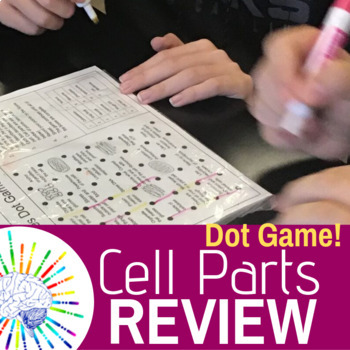Cell Parts Review Dot Game! Review the Cell Parts and Functions
- Google Drive™ folder

Description
This is a super fun game for reviewing and reinforcing the Cell Parts! NO PREP! Print and Go! Students use strategy and their knowledge of Cell Parts to gain the most points and win the game.
Players take turns going back and forth, each connecting two dots with a line. If a player draws a line that completes a box, that player ‘captures’ the organelle described inside the box. They get the points assigned to that organelle (indicated on the game sheet).
The cell part description inside each box may be a sketch of the part (mitochondria, golgi body, rough ER, ad chloroplast), or a description of what the Cell Part does. Students discuss and confirm, and go back to their notes, to decide what cell part is described so they are sure they (and their partner) get the correct number of points!
Students quickly learn that some organelles hold more points than others, which keeps them focused and interacting with content as they consider each move!
Cell Parts include:
- Cell Membrane
- Nucleus
- Endoplamic Reticulum
- Ribosomes
- Golgi Body
- Mitochondria
- Chloroplast
- Vacuole
- Lysosome
- Cell Wall
- Cytoskeleton
Also included:
- Answer Key
- Google Slide set with visual instructions to show your students how to play
There are two versions of the score sheet. One sheet is for just one round of play between two students - Player 1 and Player 2. The other score sheet is designed for two rounds of play, where each student has their own sheet, which they carry with them as they play against two different people.
I usually set a timer, rather than letting them finish out the board. This adds a bit of ‘hurry’ to the game, students are more focused on gaining points as quickly as they can. Sometimes I offer candy or some other incentive to the top score or top 5 scores in the room for each round. My students love this game and ask to play it again and again!
More Cell resources!
- NEW! Cell Membrane Transport Activity, Hands On Cell Membrane Model | Digital + PrintLet your students SEE membrane transport by making it on their desk, or drag and drop on the computer!
- Cell Organelle Notes and Activity - Digital and Printable! NO PREP, students work independently to complete, great for a Sub or distance learning!
- Cell Parts Review Dot Game!
- Cell Parts Activity - Making Connections | Digital, Distance Learning
- Cell Parts Activity - Making Analogies to Random Things | Distance Learning
- Cell Membrane Transport and Homeostasis Doodle Notes
- Cell Video: Hidden Life of the Cell (BBC) Video Guide
- Biology Cells Writing Prompts Exit Tickets, Review- Distance Learning
- Cell Parts & Membrane Transport Review- Distance Learning | DIGITAL Google Forms
Love Dot Games for Review? Check out a few others from Science of Curiosity!
Looking for more resources for Biology? Take a look!
- Cell Membrane Transport and Homeostasis Doodle Notes
- Cell Video: Hidden Life of the Cell (BBC) Video Guide
- Photosynthesis Online Activity Guided Notes
- Biomolecules Activity - Build a Protein Model to learn Protein Folding!
- Enzymes Activities & Lesson Plans with Doodle Notes, Demonstrations & Enzyme Lab
- Biomolecule BUNDLE! Doodle Notes, Activities, Projects, Review!
** Stay Curious! **





